
7,979,261,010 (2023 est.)
ten most populous countries (in millions): China 1413.14; India 1339.92; United States 339.67; Indonesia 279.48; Pakistan 247.65; Nigeria 230.84; Brazil 218.69; Bangladesh 167.18; Russia 141.7; Mexico 129.88
ten least populous countries: Holy See (Vatican City) 1,000; Niue 2,000; Saint Pierre and Miquelon 5,195; Montserrat 5,440; Saint Barthelemy 7,093; Saint Helena, Ascension, and Tristan de Cunha 7,935; Cook Islands 7,939; Nauru 9,852; Tuvalu 11,639; Wallis and Futuna 15,929
ten most densely populated countries (population per sq km): Macau 22,856.1; Monaco 15,798.5; Singapore 8,427.9; Hong Kong 6,792.3; Gaza Strip 5,660.4; Gibraltar 4,232.7; Bahrain 2,044.6; Malta 1,478.3; Bermuda 1,344; Maldives 1,343.4
ten least densely populated countries (population per sq km): Greenland 0.03; Falkland Islands 0.26; Mongolia 2.1; Namibia 3.37; Australia 3.4; Iceland 3.6; Guyana 4; Suriname 4.1; Mauritania 4.1; Libya 4.1
most-spoken language: English 18.8%, Mandarin Chinese 13.8%, Hindi 7.5%, Spanish 6.9%, French 3.4%, Arabic 3.4%, Bengali 3.4%, Russian 3.2%, Portuguese 3.2%, Urdu 2.9% (2022 est.)
most-spoken first language: Mandarin Chinese 12.3%, Spanish 6%, English 5.1%, Arabic 5.1%, Hindi 3.5%, Bengali 3.3%, Portuguese 3%, Russian 2.1%, Japanese 1.7%, Punjabi, Western 1.3%, Javanese 1.1% (2018 est.)
note 1: the six UN languages - Arabic, Chinese (Mandarin), English, French, Russian, and Spanish (Castilian) - are the mother tongue or second language of about 49.6% of the world's population (2022), and are the official languages in more than half the states in the world; some 400 languages have more than a million first-language speakers (2018)
note 2: all told, there are estimated to be 7,168 living languages spoken in the world (2023); approximately 80% of these languages are spoken by less than 100,000 people; about 150 languages are spoken by fewer than 10 people; communities that are isolated from each other in mountainous regions often develop multiple languages; Papua New Guinea, for example, boasts about 840 separate languages (2018)
note 3: approximately 2,300 languages are spoken in Asia, 2,140, in Africa, 1,310 in the Pacific, 1,060 in the Americas, and 290 in Europe (2020)
Christian 31.1%, Muslim 24.9%, Hindu 15.2%, Buddhist 6.6%, folk religions 5.6%, Jewish
0-14 years: 24.7% (male 1,013,862,872/female 954,310,632)
15-64 years: 65.2% (male 2,632,261,828/female 2,569,677,967)
65 years and over: 10.1% (male 359,529,609/female 448,106,332) (2023 est.)
total dependency ratio: 54.1
youth dependency ratio: 39.3
elderly dependency ratio: 14.8
potential support ratio: 7 (2021 est.)
total: 31 years (2020)
male: 30.3 years
female: 31.8 years
1.03% (2021 est.)
note: this rate results in about 154 net additions to the worldwide population every minute or 2.6 people every second
18.1 births/1,000 population (2020 est.)
note: this rate results in about 259 worldwide births per minute or 4.3 births every second
7.7 deaths/1,000 population (2020 est.)
note: this rate results in about 108 worldwide deaths per minute or 1.8 deaths every second
six of the world's seven continents are widely and permanently inhabited; Asia is easily the most-populous continent with about 60% of the world's population (China and India together account for over 35%); Africa comes in second with over 15% of the earth's populace, Europe has about 10%, North America 8%, South America almost 6%, and Oceania less than 1%; the harsh conditions on Antarctica prevent any permanent habitation
urban population: 57.5% of total population (2023)
rate of urbanization: 1.73% annual rate of change (2020-25 est.)
ten largest urban agglomerations: Tokyo (Japan) - 37,393,000; New Delhi (India) - 30,291,000; Shanghai (China) - 27,058,000; Sao Paulo (Brazil) - 22,043,000; Mexico City (Mexico) - 21,782,000; Dhaka (Bangladesh) - 21,006,000; Cairo (Egypt) - 20,901,000; Beijing (China) - 20,463,000; Mumbai (India) - 20,411,000; Osaka (Japan) - 19,165,000 (2020)
ten largest urban agglomerations, by continent:
Africa - Cairo (Egypt) - 20,901,000; Lagos (Nigeria) - 134,368,000; Kinshasha (DRC) - 14,342,000; Luanda (Angola) - 8,330,000; Dar Es Salaam (Tanzania) - 6,702,000; Khartoum (Sudan) - 5,829,000; Johannesburg (South Africa) - 5,783,000; Alexandria (Egypt) - 5,281,000; Abidjan (Cote d'Ivoire) - 5,203,000; Addis Ababa (Ethiopia) - 4,794,000
Asia - Tokyo (Japan) - 37,393,000; New Delhi (India) - 30,291,000; Shanghai (China) - 27,058,000; Dhaka (Bangladesh) - 21,006,000; Beijing (China) - 20,463,000; Mumbai (India) - 20,411,000; Osaka (Japan) - 19,165,000; Karachi (Pakistan) - 16,094,000; Chongqing (China) - 15,872,000; Istanbul (Turkey) - 15,190,000
Europe - Moscow (Russia) - 12,538,000; Paris (France) - 11,017,000; London (United Kingdom) - 9,304,000; Madrid (Spain) - 6,618,000; Barcelona (Spain) - 5,586,000, Saint Petersburg (Russia) - 5,468,000; Rome (Italy) - 4,257,000; Berlin (Germany) - 3,562,000; Athens (Greece) - 3,153,000; Milan (Italy) - 3,140,000
North America - Mexico City (Mexico) - 21,782,000; New York-Newark (United States) - 18,804,000; Los Angeles-Long Beach-Santa Ana (United States) - 12,447,000; Chicago (United States) - 8,865,000; Houston (United States) - 6,371,000; Dallas-Fort Worth (United States) - 6,301,000; Toronto (Canada) - 6,197,000; Miami (United States) - 6,122,000; Atlanta (United States) - 5,803,000; Philadelphia (United States) - 5,717,000
Oceania - Melbourne (Australia) - 4,968,000, Sydney (Australia) - 4,926,000; Brisbane (Australia) - 2,406,000; Perth (Australia) - 2,042,000; Auckland (New Zealand) - 1,607,000; Adelaide (Australia) - 1,336,000; Gold Coast-Tweed Head (Australia) - 699,000; Canberra (Australia) - 457,000; Newcastle-Maitland (Australia) - 450,000; Wellington (New Zealand) - 415,000
South America - Sao Paulo (Brazil) - 22,043,000; Buenos Aires (Argentina) - 15,154,000; Rio de Janeiro (Brazil) - 13,458,000; Bogota (Colombia) - 10,978,000; Lima (Peru) - 10,719,000; Santiago (Chile) - 6,767,000; Belo Horizonte (Brazil) - 6,084,000; Brasilia (Brazil) - 4,646,000; Porto Alegre (Brazil) - 4,137,000; Recife (Brazil) - 4,127,000 (2020)
at birth: 1.07 male(s)/female
0-14 years: 1.07 male(s)/female
15-64 years: 1.07 male(s)/female
65 years and over: 0.81 male(s)/female
total population: 1.01 male(s)/female (2020 est.)
211 deaths/100,000 live births (2017 est.)
total: 30.8 deaths/1,000 live births (2020 est.)
male: 32.8 deaths/1,000 live births
female: 28.6 deaths/1,000 live births
total population: 70.5 years (2020)
male: 68.4 years
female: 72.6 years
2.42 children born/woman (2020 est.)
improved: urban: 96.5% of population
rural: 84.7% of population
total: 91.1% of population
unimproved: urban: 3.5% of population
rural: 15.3% of population
total: 8.9% of population (2015 est.)
improved: urban: 82.3% of population
rural: 50.5% of population
total: 67.7% of population
unimproved: urban: 17.7% of population
rural: 49.5% of population
total: 32.3% of population (2015 est.)
food or waterborne diseases:Typhoid fever - An estimated 26 million cases of typhoid fever and 5 million cases of paratyphoid fever occur worldwide each year, causing 215,000 deaths. High-risk regions for typhoid and paratyphoid fever include Africa and Southeast Asia; lower-risk regions include East Asia, South America, and the Caribbean. Typhoid fever is a life-threatening illness caused by Salmonella Typhi bacteria. Paratyphoid fever is a life-threatening illness caused by Salmonella Paratyphi bacteria. The bacteria that cause typhoid fever are most often spread through contaminated food and water and person to person contact. Symptoms of typhoid fever include high fever, weakness, stomach pain, headache, constipation or diarrhea, cough, and loss of appetite. Typhoid fever can be fatal without appropriate antibiotic treatment. CDC recommends that all travelers (even short-term travelers) to affected areas be vaccinated against typhoid fever before travel.
vectorborne diseases:Malaria - In 2020, an estimated 627,000 people died of malaria—most were young children in sub-Saharan Africa. Nearly half the world’s population lives in areas at risk of malaria transmission in 87 countries and territories (see attached map). In 2020, malaria caused an estimated 241 million clinical episodes, and 627,000 deaths. An estimated 95% of deaths in 2020 were in the WHO African Region. The predominant parasite species is Plasmodium falciparum, which is the species that is most likely to cause severe malaria and death. Where malaria is found depends mainly on climatic factors such as temperature, humidity, and rainfall. Malaria is transmitted in tropical and subtropical areas, where Anopheles mosquitoes can survive and multiply, and malaria parasites can complete their growth cycle in the mosquitoes (“extrinsic incubation period”). Temperature is particularly critical. For example, at temperatures below 20°C (68°F), Plasmodium falciparum (which causes severe malaria) cannot complete its growth cycle in the Anopheles mosquito, and thus cannot be transmitted.
African Trypanosomiasis - also known as “sleeping sickness”, is caused by microscopic parasites of the species Trypanosoma brucei. It is transmitted by the tsetse fly (Glossina species), which is found only in sub-Saharan Africa. Two morphologically indistinguishable subspecies of the parasite cause distinct disease patterns in humans: T. b. gambiense causes a slowly progressing African trypanosomiasis in western and central Africa and T. b. rhodesiense causes a more acute African trypanosomiasis in eastern and southern Africa. Control efforts have reduced the number of annual cases and for the first time in 50 years, the number of reported cases fell under 10,000 in 2009. In 2017–2018, fewer than 2000 cases were reported to WHO. The number of cases continue to drop and in 2020, fewer than 700 combined cases were reported to WHO; over 85% caused by T. b. gambiense and around 15% caused by T. b. rhodesiense. Sleeping sickness is curable with medication but is fatal if left untreated.
Dengue fever - Dengue viruses are spread to people through the bite of an infected Aedes species (Ae. aegypti or Ae. albopictus) mosquito. Almost half of the world’s population, about 4 billion people, live in areas with a risk of dengue. Dengue is often a leading cause of illness in areas with risk. Each year, up to 400 million people get infected with dengue. Approximately 100 million people get sick from infection, and 40,000 die from severe dengue. Dengue has emerged as a worldwide problem since the 1960s. The disease is common in many popular tourist destinations in the Caribbean (including Puerto Rico), Central and South America, Southeast Asia, and the Pacific Islands (see attached regional maps). In the United States, local cases and limited spread of dengue does occur periodically in some states with hot, humid climates and Aedes mosquitoes.
water contact diseases:Schistosomaisis - also known as bilharzia, is a disease caused by parasitic worms. In terms of impact this disease is second only to malaria as the most devastating parasitic disease (see attached map). Schistosomiasis is considered one of the neglected tropical diseases (NTDs). The parasites that cause schistosomiasis live in certain types of freshwater snails. The infectious form of the parasite, known as cercariae, emerge from the snail into the water. You can become infected when your skin comes in contact with contaminated freshwater. Most human infections are caused by Schistosoma mansoni, S. haematobium, or S. japonicum. Freshwater becomes contaminated by Schistosoma eggs when infected people urinate or defecate in the water. The eggs hatch, and if certain types of freshwater snails are present in the water, the parasites develop and multiply inside the snails. The parasite leaves the snail and enters the water where it can survive for about 48 hours. Schistosoma parasites can penetrate the skin of persons who are wading, swimming, bathing, or washing in contaminated water.
respiratory diseases:Meningococcal meningitis - Meningococcal disease occurs worldwide, with the highest incidence of disease found in the ‘meningitis belt’ of sub-Saharan Africa (see attached map). In this region, major epidemics occur every 5 to 12 years with attack rates reaching 1,000 cases per 100,000 population. Bacteria called Neisseria meningitidis cause meningococcal disease. About 1 in 10 people have these bacteria in the back of their nose and throat without being ill. This is called being ‘a carrier.’ Sometimes the bacteria invade the body and cause certain illnesses, which are known as meningococcal disease. Other regions of the world experience lower overall rates of disease and occasional outbreaks. Annual attack rates in these regions averages around 0.3 to 3 per 100,000 population. Risk factors for meningococcal disease outbreaks in Africa are not fully understood. However, the following characteristics create favorable conditions for meningococcal disease epidemics: Dry and dusty conditions during the dry season between December to June, Immunological susceptibility of the population, Travel and large population displacements, Crowded living conditions
note 1: widespread ongoing transmission of a respiratory illness caused by the novel coronavirus (COVID-19) is occurring globally; older adults and people of any age with serious chronic medical conditions are at increased risk for severe disease; as of 23 August 2023, 769,806,130 confirmed cases of COVID-19 and 6,955,497 deaths had been reported to the World Health Organization; as of 23 August 2023, 70.5% of the World population had received at least one dose of COVID-19 vaccine
note 2: on 31 August 2023, the US Centers for Disease Control and Prevention (CDC) issued a Travel Alert for some international destinations (see attached map) currently considered a high risk to travelers for circulating vaccine-derived polioviruses (cVDPV); vaccine-derived poliovirus (VDPV) is a strain of the weakened poliovirus that was initially included in oral polio vaccine (OPV) and that has changed over time and behaves more like the wild or naturally occurring virus; this means it can be spread more easily to people who are unvaccinated against polio and who come in contact with the stool or respiratory secretions, such as from a sneeze, of an “infected” person who received oral polio vaccine; the CDC recommends that before any international travel, anyone unvaccinated, incompletely vaccinated, or with an unknown polio vaccination status should complete the routine polio vaccine series; before travel to any high-risk destination, the CDC recommends that adults who previously completed the full, routine polio vaccine series receive a single, lifetime booster dose of polio vaccine
Map showing an approximation of the parts of the world where malaria transmission occurs:  International destinations known to have circulating poliovirus:
International destinations known to have circulating poliovirus: 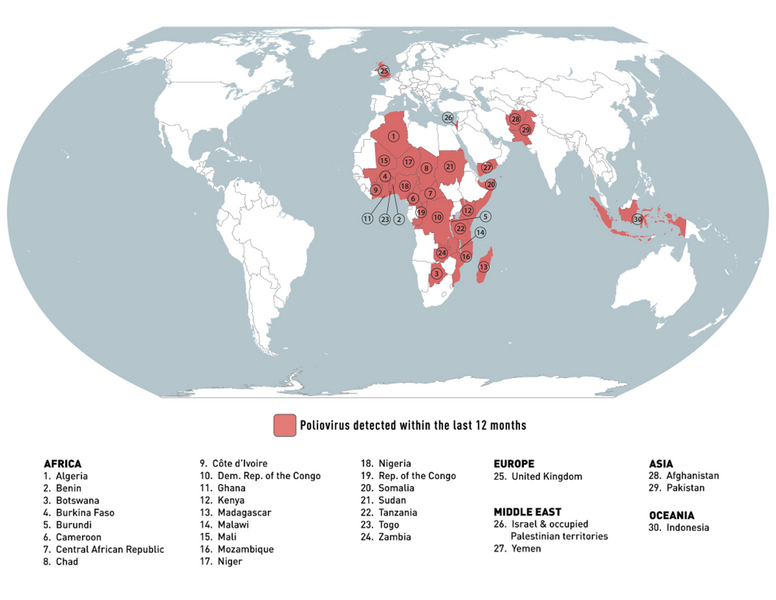 Map depicting those countries where schistosomiasis transmission has been reported:
Map depicting those countries where schistosomiasis transmission has been reported: 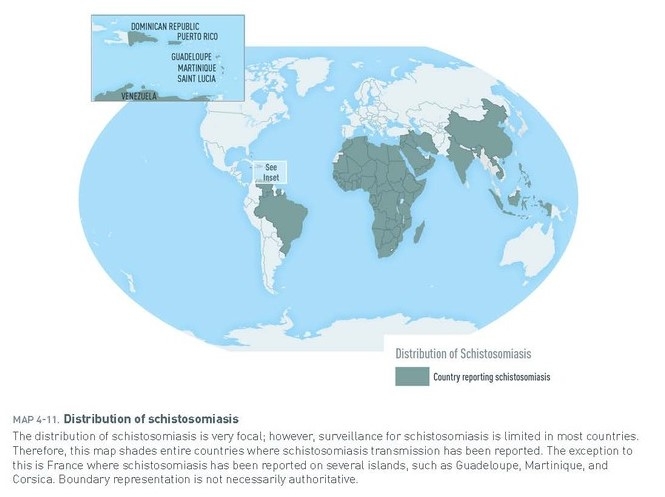 Map depicting the risk of Dengue fever in Africa and the Middle East:
Map depicting the risk of Dengue fever in Africa and the Middle East: 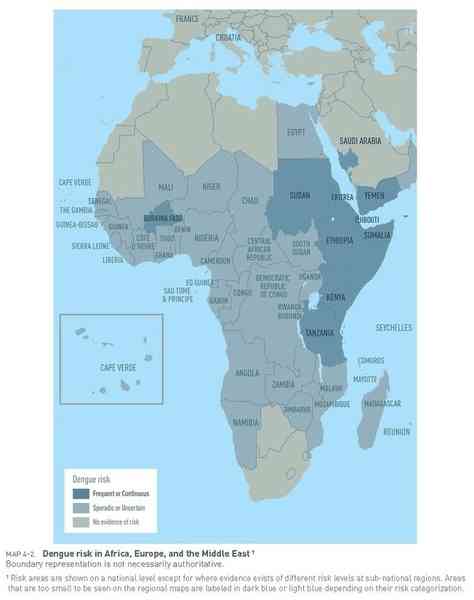 Map depicting those area at risk for Dengue fever in the Western Hemisphere:
Map depicting those area at risk for Dengue fever in the Western Hemisphere: 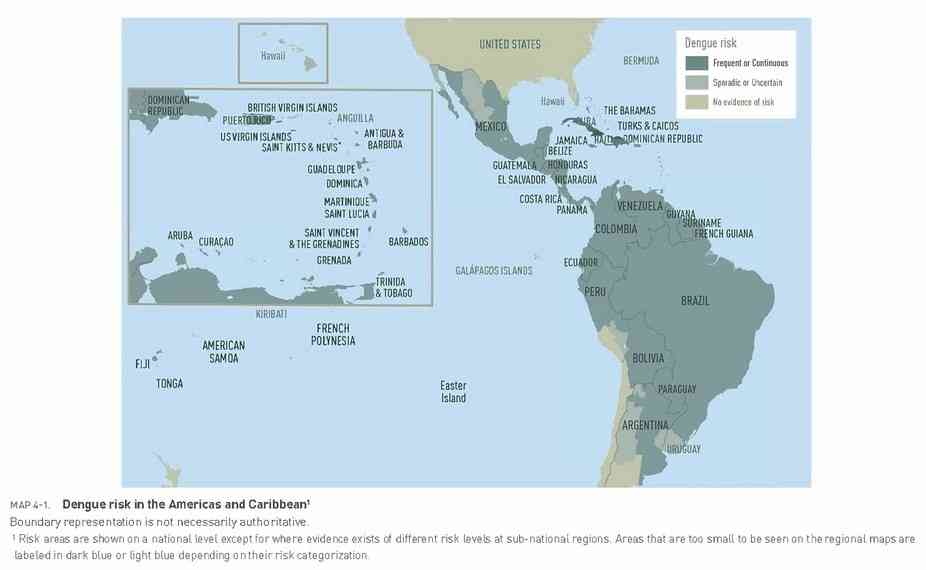 Map depicting the risk of Dengue fever in South Asia, Southeast Asia, and the Pacific Islands areas:
Map depicting the risk of Dengue fever in South Asia, Southeast Asia, and the Pacific Islands areas:  N. meningitidis is found worldwide, but the highest incidence occurs in the “meningitis belt” of sub-Saharan Africa shown here:
N. meningitidis is found worldwide, but the highest incidence occurs in the “meningitis belt” of sub-Saharan Africa shown here: 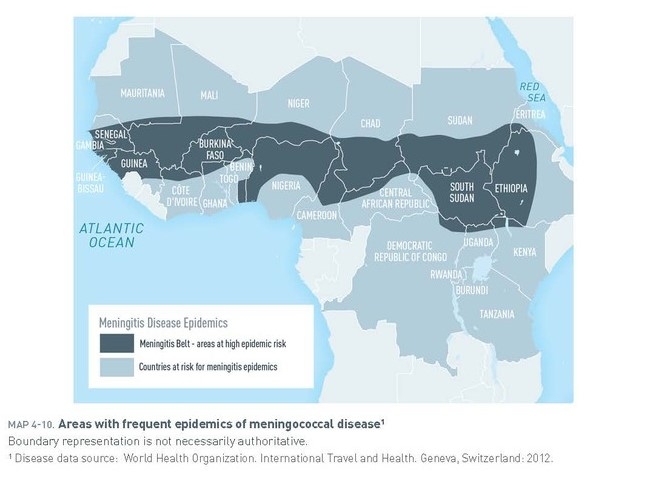
66.2% (2023 est.)
women married by age 15: 5%
women married by age 18: 18.7% (2022 est.)
men married by age 18: 2.8% (2021 est.)
definition: age 15 and over can read and write
total population: 86.7%
male: 90.1%
female: 83.3% (2020)
note: more than three quarters of the world's 750 million illiterate adults are found in South Asia and sub-Saharan Africa; of all the illiterate adults in the world, almost two thirds are women (2016)
total: 13 years
male: 13 years
female: 13 years (2020)
NOTE: The information regarding World on this page is re-published from the 2024 World Fact Book of the United States Central Intelligence Agency and other sources. No claims are made regarding the accuracy of World 2024 information contained here. All suggestions for corrections of any errors about World 2024 should be addressed to the CIA or the source cited on each page.
This page was last modified 04 May 24, Copyright © 2024 ITA all rights reserved.